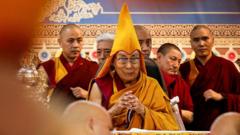What Is the Dalai Lama's Story and Why Is He Living in Exile?

The Journey of the 14th Dalai Lama: A Tale of Resilience, Leadership, and Legacy
In March 1959, amidst a turbulent period marked by military intervention and cultural suppression, Tenzin Gyatso, the 14th Dalai Lama, fled to India, setting into motion a remarkable journey of resilience that would span decades. With the Chinese government's military presence looming over Tibet, the young Dalai Lama faced immense challenges as he sought to protect the Tibetan people and their rich cultural heritage. Today, he stands as not only the spiritual leader of the Tibetan community but also a global symbol of peace and non-violence.
This article will explore the life of the Dalai Lama, his escape from Tibet, his advocacy for Tibetan autonomy, and the future of the Dalai Lama institution. Through a detailed examination of his life and beliefs, we will uncover the essence of a leader who has inspired millions around the world.
Early Life and Recognition
Tenzin Gyatso was born on July 6, 1935, in a small village outside of what is now recognized as Tibet. His humble beginnings as the son of farmers shaped his early values and perspectives. At just two years old, he was identified by a search party of Buddhist officials as the reincarnation of the 13 previous Dalai Lamas, a significant honor that led to his enthronement before he turned four. This recognition marked the beginning of a life dedicated to spiritual leadership.
Education and Early Responsibilities
The Dalai Lama was raised in a monastic environment where he received extensive education in Buddhist philosophy. He achieved the prestigious Geshe Lharampa Degree, a doctorate equivalent in Buddhist studies. His early education laid the groundwork for his future role as a spiritual and political leader. By the time he was 15, he was thrust into the role of head of state as China’s Communist troops invaded Tibet in 1950.
The Invasion of Tibet and the Flight to India
As Chinese troops marched into Tibet, the Dalai Lama found himself in a precarious position, tasked with leading his people amid increasing political unrest. In May 1951, a controversial 17-point agreement was imposed by China, legitimizing Tibet's incorporation into the People's Republic of China. This agreement was met with widespread dissent among the Tibetan populace, leading to fear and tension.
The Uprising and Escape
On March 10, 1959, a dramatic uprising erupted in Lhasa, the Tibetan capital, following fears that the Dalai Lama would be abducted by Chinese forces. In a desperate bid to protect his life, he disguised himself as a soldier and fled the palace under the cover of darkness. Accompanied by a small entourage, he embarked on a treacherous 15-day journey across the Himalayas, ultimately reaching the border of India.
The Indian government granted him asylum, and he settled in Dharamshala, which became the seat of the Tibetan government-in-exile. This relocation allowed him to continue his work of preserving Tibetan culture and advocating for the rights of his people.
Advocacy for Tibetan Rights
In exile, the Dalai Lama dedicated himself to advocating for Tibetan autonomy while maintaining a commitment to non-violence. He made significant efforts to bring international attention to the plight of Tibetans through appeals to the United Nations and other global platforms. His efforts culminated in the adoption of multiple resolutions by the UN General Assembly, emphasizing the need for the protection of the Tibetan people.
The Middle Way Approach
One of the most notable contributions of the Dalai Lama to the Tibetan cause is his "Middle Way" approach, which advocates for genuine self-rule for Tibet within the framework of the Chinese state. This philosophy seeks a peaceful resolution to the Tibetan issue without resorting to violence, a stance that has garnered both praise and criticism from various quarters.
International Recognition and the Nobel Peace Prize
In 1989, the Dalai Lama was awarded the Nobel Peace Prize for his unwavering commitment to non-violence and his advocacy for the rights of the Tibetan people. The Nobel committee lauded his approach as "all the more remarkable" given the suffering endured by Tibetans under Chinese rule. This recognition elevated his status as a global peace icon and allowed him to reach a wider audience.
Global Influence and Collaborations
Throughout his life, the Dalai Lama has formed alliances with various political and religious leaders across the globe. He has met with prominent figures such as Pope John Paul II and has co-authored works with notable activists like Archbishop Desmond Tutu. His influence extends into popular culture as well, with support from Hollywood luminaries such as Richard Gere and Lady Gaga.
Challenges and Controversies
Despite his extensive efforts to promote peace, the Dalai Lama's philosophy has not been without its challenges. Some Tibetans have criticized him for being too lenient toward the Chinese government, arguing that his non-violent stance has hindered the fight for Tibetan independence. The 2008 riots in Lhasa highlighted the growing frustration among Tibetans with the Chinese government's policies and the perceived inadequacies of the Dalai Lama's approach.
Recent Controversies
In recent years, the Dalai Lama has also faced scrutiny due to a few controversial statements and incidents. One notable incident occurred in 2023 when a video surfaced showing him engaging in what some deemed inappropriate behavior with a child. His office later clarified that the Dalai Lama often employs playful teasing as part of his interactions. Furthermore, his comments regarding the attractiveness of a potential female successor drew backlash and necessitated an apology.
The Transition of Political Authority
Historically, the Dalai Lama has served as both the spiritual and political leader of the Tibetan people. However, in March 2011, he made a significant decision to relinquish his political authority to a democratically elected government-in-exile. This move marked a new chapter for the Tibetan movement, emphasizing the importance of democratic governance while still retaining his spiritual leadership role.
Succession and Future of the Dalai Lama Institution
As the Dalai Lama advanced in age and faced health challenges, concerns about his succession grew. In the past, he had suggested that there may not be a reincarnation of the Dalai Lama, raising questions about the future of the institution. However, upon turning 90 in June 2025, he confirmed that there would indeed be a successor, thereby assuring the continuation of the 600-year-old Buddhist tradition.
His statement indicated that the future Dalai Lama would be recognized solely by his office, countering China's claims that it holds authority over the succession process. The Dalai Lama further asserted that his successor would be born in a "free world" outside of China, signaling a message of hope for Tibetans and a challenge to Beijing’s stance on Tibetan autonomy.
Conclusion: A Legacy of Peace and Hope
The life of the 14th Dalai Lama is a testament to resilience in the face of adversity. His journey from a young boy recognized as a spiritual leader to a global icon of peace has inspired millions worldwide. As he prepares for the next chapter of his legacy, the Dalai Lama remains a symbol of hope for Tibetans and advocates of non-violence everywhere.
In contemplating the future of the Dalai Lama institution and the Tibetan cause, we are left with an essential question: How will the world respond to the ongoing struggles of Tibetans and the quest for genuine autonomy? The impact of the Dalai Lama's teachings and philosophy will undoubtedly resonate for generations to come.
FAQs
What is the significance of the Dalai Lama's escape to India?
The Dalai Lama's escape to India in 1959 marked a pivotal moment in Tibetan history, allowing him to continue advocating for Tibetan rights and preserving Tibetan culture while in exile.
How has the Dalai Lama influenced the global perception of Tibet?
Through his advocacy and teachings, the Dalai Lama has raised global awareness about the plight of Tibetans, promoting a message of peace and non-violence that resonates with many around the world.
What is the Middle Way approach proposed by the Dalai Lama?
The Middle Way approach advocates for genuine self-rule for Tibet within the framework of the Chinese state, seeking a peaceful resolution to the Tibetan issue without resorting to violence.
What are the challenges the Dalai Lama has faced in his leadership?
Despite his peaceful approach, the Dalai Lama has faced criticism from some Tibetans for being too lenient toward the Chinese government, as well as controversies surrounding his public statements and behavior.
What does the future hold for the Dalai Lama institution?
With the Dalai Lama confirming the continuation of the institution after his passing, there is hope for the future of Tibetan Buddhism and culture, particularly in the context of its relationship with China.
As we reflect on the Dalai Lama's life and teachings, let us consider the ongoing struggles for peace and autonomy in Tibet. How will the next generation of leaders carry forward this legacy? #DalaiLama #Tibet #Peace
Published: 2025-07-02 12:34:14 | Category: technology



